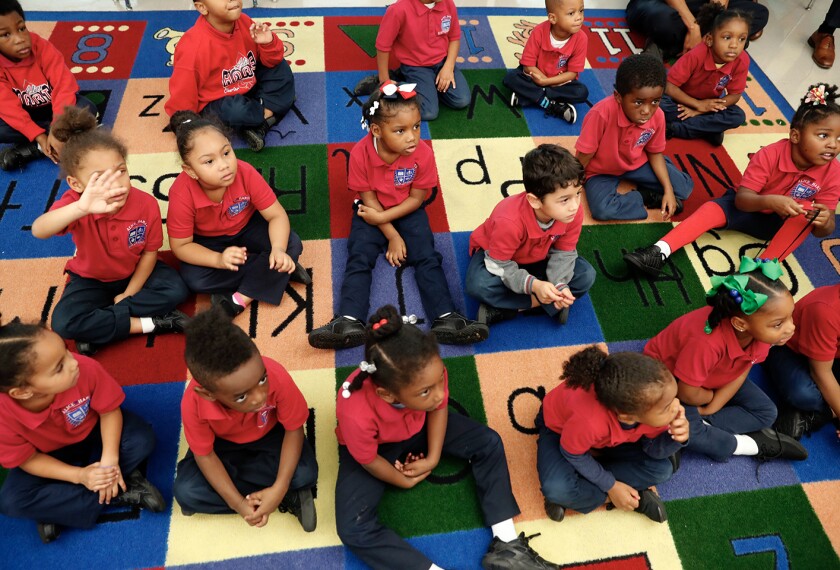Young children who took part in an intervention program run by the Chicago public schools continue to benefit from the services well into adulthood, a study released today shows.
At age 24, the adults had acquired more education and were less likely to commit crimes than those who did not receive the same level of service.
In addition, the sample that attended the district’s Child-Parent Centers—which serve preschoolers through 3rd graders—were more likely to have health insurance and be less apt to exhibit symptoms of depression.
“This study provides evidence that established early educational interventions can positively influence the adult life course in several domains of functioning,” writes Arthur J. Reynolds, a child-development professor at the University of Minnesota in Minneapolis and the director of the study, which appears in the August issue of the Archives of Pediatrics and Adolescent Medicine, a monthly journal. “That the impacts of intervention extend beyond educational performance is not surprising given the well-documented links between education outcomes and adult health, mental health, and social behavior.”
In an e-mail, he added that “these findings are especially relevant to schools and policymakers in decisions about modifying existing programs or expanding access to early education.”
The Chicago Longitudinal Study, which started more than 20 years ago, originally included 1,539 children from low-income African-American and Hispanic families who began the program at 25 sites in either 1985 or 1986.
For the study of 24-year-olds, data were available for 1,389 people—902 of whom participated in the program and 487 of whom were enrolled in other types of early-childhood programs or attended full-day kindergarten but didn’t attend preschool.
Comprehensive Services
The Child-Parent Centers program began in 1967 at sites located either in or close to elementary schools. Similar to the federal Head Start program, the Child-Parent Centers provide comprehensive education, health, and family-support services to children from 3 through 9. Parents are expected to participate in the classroom, and children are sometimes visited in their homes.
While the connection between preschool teachers with bachelor’s degrees and learning outcomes for children is still being debated among some experts in the field, Mr. Reynolds said that feature contributed to the program’s lasting success.
“Well-trained and well-compensated staff are common for programs demonstrating long-term effects,” he writes.
Together with the High/Scope Perry Preschool study in Ypsilanti, Mich., and the Abecedarian project in Chapel Hill, N.C., the Child-Parent Centers program is known for leading to long-term positive outcomes and, as a result, economic benefits for society, such as lower special education costs and less welfare dependency.
Respected economists, such as the University of Chicago’s James J. Heckman, a Nobel Prize winner, are even promoting preschool programs as a wise economic-development strategy.
“Private gains are a substantial benefit of such programs, and are important for the evaluation of these programs on the grounds of social justice,” Mr. Heckman wrote in “The Productivity Argument for Investing in Young Children,” a 2004 paper. “However, it is the large social benefits for the general public—stemming from the savings to taxpayers, victims of crime, and employers—that make the firmest case for these programs.”
Unlike the other two programs, the Child-Parent Centers program—which continues today—is not a small demonstration project. It is run by an urban school district, which leads many universal preschool advocates to argue that large-scale programs can be successful.
Nevertheless, Mr. Reynolds cautions against expecting such results from the many state-financed ventures currently operating throughout the country.
“The intervention effects are most likely to be reproduced in urban contexts serving relatively high concentrations of low-income children,” the study says.
Supporters of statewide, universal pre-K programs, however, are not deterred by such statements.
“We continue to believe that all kids benefit from pre-K,” says Libby Doggett, the executive director of Pre-K Now, a Washington-based advocacy group pushing for government-financed preschool for all children, regardless of their parents’ income level.
The results of Mr. Reynolds’ research also support a growing movement to better connect preschool programs to curriculum and experiences in the primary grades.
Mr. Reynolds was able to isolate benefits that were linked to full participation in the “extended intervention” through the primary grades, including lower rates of arrests for violence, higher rates of full-time employment, and higher rates of holding private health insurance.
“As more and more states and school districts either have pre-K programs in their schools or their communities, they begin to realize that it’s to their advantage to have some kind of connection with those programs,” said Ruby Takanishi, the president of the New York City-based Foundation for Child Development, which has been heavily engaged in promoting pre-K to 3 programs.
She argues that while many district leaders are supportive of serving preschool children, too few are taking advantage of the ability to use federal Title I money—the funding source used for the Child-Parent Centers program—to pay for it.
In a paper Mr. Reynolds co-wrote last year for the foundation on pre-K to 3 programs, he noted that less than 5 percent of Title I funds are currently spent on preschool programs.
“Joint funding or matching grants between federal and state sources would be one approach to cost sharing that could improve the opportunities for funding,” the paper suggested.
Not an Antidote
Even with the link between the Child-Parent Centers program and later positive outcomes, Mr. Reynolds points out, as other researchers have, that early-childhood-intervention programs do not completely protect children against the effects of poverty.
Although program participants were more likely than the control group to attend four-year colleges, only a small proportion did so—14.7 percent, compared with 10 percent.
And so far, Mr. Reynolds writes, “higher levels of education have not resulted in significant differences in income.”
Continuing follow-up studies, however, will likely present a more accurate picture of the participants’ socioeconomic status. The adults in the sample are now 27, and Mr. Reynolds’ study will follow them at least until age 30.



